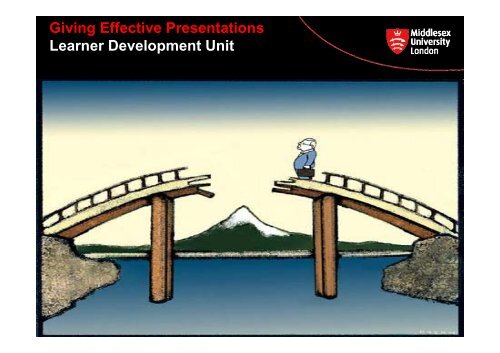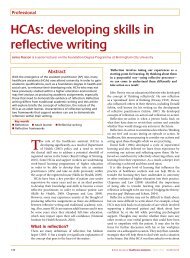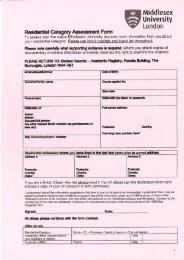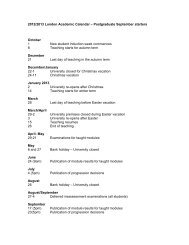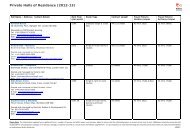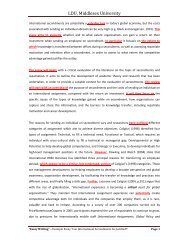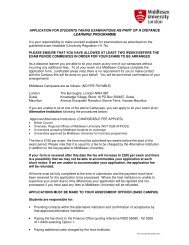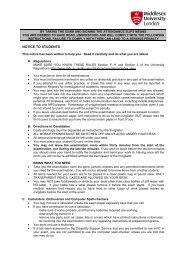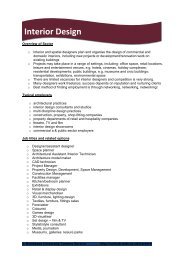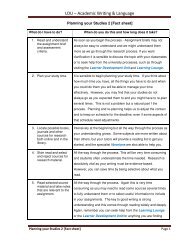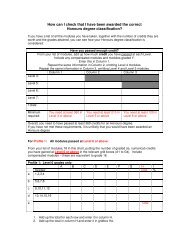Giving Effective Presentations Learner Development Unit - UniHub
Giving Effective Presentations Learner Development Unit - UniHub
Giving Effective Presentations Learner Development Unit - UniHub
Create successful ePaper yourself
Turn your PDF publications into a flip-book with our unique Google optimized e-Paper software.
<strong>Giving</strong> <strong>Effective</strong> <strong>Presentations</strong><br />
<strong>Learner</strong> <strong>Development</strong> <strong>Unit</strong>
Aims<br />
• Ri Raise awareness of f what htconstitutes tit t an<br />
effective presentation<br />
p<br />
• Discuss how to prepare good visual aids<br />
• Discuss how to deal with questions<br />
• Discuss using your voice effectively<br />
• [Give opportunity to practise presenting]<br />
• AOB
Important Characteristics<br />
of f P<strong>Presentations</strong> t ti<br />
• Clear speaker↔audience roles<br />
• Audience can’t clarify meanings<br />
• Pre‐planned speaking [cf. ‘usual’<br />
speaking]<br />
• Needs structure; aims; engagement<br />
• Extended length of speaking turn<br />
• Needs language to help audience follow<br />
• Requires careful planning<br />
• Demands d skilful klf ldl delivery
‘Typical’ Speaking ≠ Presenting …<br />
• ‘Typical’ Typical Speaking …<br />
• Listener is actively involved –s/he can easily clarify<br />
speaker’s meanings, ideas, links between ideas<br />
• Li Listener t is i actively ti l iinvolved l d– speaker k can constantly t tl<br />
notice / monitor their comprehension / understanding<br />
• Context is explicitly p yshared – links between points, p , ideas<br />
etc are obvious & apparent [if not, see above!]<br />
• Speaking in a Presentation …<br />
• Listener i is i less l directly di l involved i l d – s/he /h cannot<br />
interrupt to clarify presenter’s meanings, ideas etc …<br />
• Listener is ‘distant’ distant – presenter has less ways of<br />
monitoring listeners’ interpretation of text …<br />
• Context is not shared – links between speaker’s points,<br />
ideas etc may not be as obvious & apparent as the<br />
presenter thinks [and if not, see above!]
Plus …<br />
• Language is a very slippery phenomenon<br />
• Think of all those “communication problems” you’ve<br />
had with loved ones<br />
• Think of all those times when you can’t believe that<br />
someone can’t get your point – is the world mad? Or<br />
is your point maybe in fact perhaps not quite as clear<br />
as you, the h thinker, h k think h kit<br />
is … ?<br />
• Think how people p p sometimes even deliberately y<br />
twist your meanings … it’s very easy to do …<br />
• Think of politicians, politicians lawyers etc
Implications …<br />
• You need to be very very VERY direct & explicit about your<br />
meanings, directions, links etc<br />
• Powerful & decisive introductions<br />
• Clear transitions [pauses + explicit language]<br />
• Clear signalling [at the ends & beginnings of different<br />
sections]<br />
• Always be wise to how people *might* be able to interpret<br />
your points … some potential interpretations may not<br />
match your intended interpretations<br />
• A street‐wise street wise approach is essential
Things to avoid<br />
1) Helping Audience<br />
• No explicitly l l stated d AIMS<br />
• No introduction of content<br />
• No introduction of structure<br />
• NNo outlining tli i of f scope [ [areas tto bbe covered] d]<br />
• Disorganised g content<br />
• No clear signalling of topic changes<br />
• Abrupt finish & no offers to take questions
Things to avoid<br />
2) Delivery<br />
• Reading aloud<br />
• Mumbling g<br />
• Monotonous delivery<br />
• Speaking very quickly<br />
• No eye contact with audience<br />
• No gestures<br />
• <strong>Giving</strong> dense / difficult information without any<br />
explanation l ti<br />
• Hands in pocket
Things to avoid<br />
3) Manners M<br />
• no greetings<br />
• no visual aids / unclear visual aids<br />
• use of language which audience will not understand<br />
• inadequate preparation<br />
• very dense information<br />
• turning your back to the audience<br />
• not talking about the topic<br />
• not sticking to time<br />
• abrupt finish<br />
• no offers to take questions
Things to do when<br />
presenting 1) ...<br />
• Outline AIMS in intro (i.e. (i e your thesis)<br />
• Outline main points p / topical p areas in intro<br />
• Highlight scope & perspective & focus in intro<br />
• Remember b the h llimitations of f the h human h brain b<br />
• Outline sections before + after saying them<br />
• Summarise frequently to help audience see<br />
your argument & how h iit fi fits together h<br />
• Make sure to return to your main thesis at<br />
Make sure to return to your main thesis at<br />
the end & finish conclusively
Things to do<br />
when presenting 2) ...<br />
• Pl Plan carefully f ll but b td don’t ’tread d aloud l d<br />
• Speak p clearly y & articulately y & with verve<br />
• Remember your audience are there – look<br />
at them!<br />
• Use your hands / arms to help get your<br />
ideas across [and of course your voice!]<br />
• Explain things which need explaining<br />
• Keep hands out of pockets?
Speaking to Persuade<br />
Preparation<br />
Organisation<br />
• Identify your purpose • ? Catchy opening?<br />
• Be clear what your talk • Clear statement of aims<br />
is / not about • Overview of whole talk<br />
• Analyse audience • [The talk itself]<br />
expectations etc • Summary of f main points<br />
• Gather information • Memorable conclusion<br />
• Devise structure &<br />
logical steps / premises<br />
• Prepare visual aids
‘Helping’ Language to …<br />
ii. GGreet taudience di & introduce i t d presenter(s) t ( )<br />
ii. Give initial introduction of topic / content /<br />
structure / aims i of f presentation i<br />
iii. Deal with questions<br />
iv. Finish a point / area during your presentation<br />
[before [ yyou move on to the next point p / area] ]<br />
v. Move on to a new point / area during your<br />
presentation<br />
p<br />
vi. Refer to a visual aid<br />
vii vii. Give overall summary of / ending to<br />
presentation
Some Language<br />
ffor Presenting P ti 1) ...<br />
• I’d like to talk about three things today<br />
• Today I’m going to talk about three things<br />
• I’m going to talk about X, Y and Z, while my colleague,<br />
[NAME], is going to talk about A,B and C<br />
• Today I’m / we’re going to show you …<br />
• Good morning ladies and gentlemen<br />
• I’ve divided my talk into three main points<br />
• Let’s begin with a question …<br />
• Ok, so this is what I’m going to be talking about today<br />
• So, the first point / to begin with, …<br />
• So, to start / begin with, let’s consider …
Some Language<br />
ffor Presenting P ti 2) ...<br />
• Could you leave any questions / interruptions until the end<br />
please<br />
• If you have h any questions, ti please l lleave th them until til th the endd<br />
• I’ve got a handout here for you which I’ll give you now / at<br />
the end<br />
• Thank you very much for listening<br />
• Ok Ok, so that’s that s pretty much all Ive I’ve got to say really really, but I’d Id be<br />
delighted to (try to) answer any questions you may have<br />
• Ok, so we’ve we ve looked at X, Y and Z, and seen that … now, has<br />
anyone got any questions?
Some Language<br />
ffor Presenting P ti 3) ...<br />
• Ok, so that’s all I’ve got to say on the third point<br />
• Now. This (of course) raises the question of …. So now I’ll move on<br />
and d …<br />
• Ok, so we’ve looked at … Now what about this fourth point? Ok, well<br />
…<br />
• Now, the third thing which I’d like to talk about today is …<br />
• Ok, so that’s the second point<br />
• Now, what about this third point? Ok, well …<br />
• Now I’ve divided this third point into the following ideas<br />
• Ok Ok, so the third thing we’re we re going to look at is …<br />
• Ok, now I’d like to turn to the third point, which is …<br />
• Now let’s move on to have a look at …<br />
• Now I’m going to talk about the third point, which is …
Some Language<br />
ffor Presenting P ti 4) ...<br />
• As you can see here / on this map / in this diagram / in this<br />
picture picture, …<br />
• Ok, this is a diagram / map / picture which shows …<br />
• Ok Ok, so what do I / we mean by [WORD / CONCEPT / IDEA]?<br />
Well, …<br />
• Now what I mean by [WORD / CONCEPT / IDEA] is …
Some Language<br />
ffor Presenting P ti 5) ...<br />
• Ok Ok, …<br />
• So, , …<br />
• Well, …<br />
• Now, …
Bigger Picture<br />
• Active listening in communication<br />
• Body language in communication<br />
• Spoken discourse markers (well; so; now;<br />
okay) [managing message / audience]<br />
• The concept of “face” in communication<br />
• Face‐threatening Acts [FTAs] ⇒ more<br />
words + minimisers (e (e.g. g just; quite;<br />
slightly; apologies)<br />
• Use of the voice for meaning [stress]
Body Language 1<br />
• In oral communication, communication some research*<br />
suggests we convey our message as follows:<br />
Wh What t we say 7%<br />
How we say y it (pace, (p , vol, , emph) p ) 38%<br />
Our body language 55%<br />
* Mehrabian, A. & Wiener, M. (1967). Decoding of inconsistent communications. Journal of<br />
personality and social psychology 6(1): 109‐114.<br />
Mehrabian, A. & Ferris, S. (1967). Inference of attitudes from nonverbal communication in<br />
two channels. Journal of consulting psychology 31 (3): 248‐252.
Body Language 2<br />
II. Facial expression<br />
II. Gaze –not maintaining eye contact is a sign of<br />
di dishonesty h or of f politeness? li ?<br />
III. Posture – this can speak p volumes<br />
IV. Gesture<br />
VV. Pro Proximity imit<br />
VI. Touch – can be formal (a handshake on first<br />
meeting), or informal (hugging a friend)<br />
VII. Personal appearance – style of dress,<br />
cleanliness, grooming –important?
Using Your Voice<br />
• BBy playing l i around d with ith pace ( (speed d& & pauses), )<br />
emphasis (which words are stressed), pitch<br />
(how high or deep the voice is) and volume volume, give<br />
these sentences some of the different meanings<br />
they might have<br />
• Do you know what the time<br />
i? is?<br />
• The rubbish bin is full. f<br />
• What are you doing?<br />
• It’s cold in here.<br />
here
Dealing with Questions …<br />
‐ Check you / the audience have understood<br />
the point / the question / query:<br />
‐ “Sorry y but I didn’t quite q get g what yyou<br />
said”<br />
‐ “Could you just repeat that”<br />
‐ “Sorry Sorry. But I don don’t t quite get what you<br />
mean. Are you saying …?”<br />
‐ [“just” & “(not) quite” reduces FTA]
Negotiation of<br />
Meaning / Message:<br />
• “ “Okay. k So you mean ...?” ?”<br />
• “Okay. So you’re saying ...?”<br />
• “But. What. You mean ...??”<br />
• “But what exactly do you mean by “X”?”<br />
• “But I understand it differently”<br />
• “But But my take’s take s slightly different / not really the same. same.”<br />
• “Well That’s not exactly my point What I’m saying is<br />
Well. That s not exactly my point. What Im saying is<br />
...”
Stating an Opinion<br />
• AAccording di to t me = X [“according [“ di to t another th<br />
person” p = yes y but not “according g to me”] ]<br />
• I believe / I think / In my opinion<br />
• My take on this is that ...<br />
• My opinion here is that ...<br />
• I’d Id say that ...
“Quite” & “Just”<br />
‐ “S “Sorry but b I didn’t did ’ quite it get what h you said” id”<br />
‐ “Sorry. y But I don’t quite q get g what yyou<br />
mean. Are<br />
you saying …?”<br />
‐ “That’s That s not quite what I mean mean. What I mean .. ”<br />
‐ “That’s not my point. I’m just saying that …”<br />
‐ “I’m just going to pop out to get a coffee”<br />
‐ [“just” [just & “(not) (not) quite” quite reduces FTA]<br />
‐ (cf. I’m quite happy / it’s quite hot / that’s quite<br />
right / I’ve just arrived / that’s just my point /<br />
there are just seven of us)
Disagreeing<br />
• Importance of FACE in communication<br />
• “II see what you’re saying but ... ”<br />
• “I get g yyour point p but ...”<br />
• “I take your point but ...”<br />
• “Okay. I see what you’re saying. But looking<br />
at the bigger gg p picture, , what about the loss of<br />
jobs that would inevitably result? Is that<br />
really a price worth paying? Is it a price we<br />
can even afford to pay?”
Using References<br />
iin a PPresentation t ti 1) 1):<br />
• According to Smith (2009), …<br />
• For Smith (2009), …<br />
• AAccording di to t the th paper / research, h …
Using References<br />
iin a PPresentation t ti 2) 2):<br />
• Smith (2009)<br />
• suggests that …<br />
• says that …<br />
• argues that h …<br />
• claims that …<br />
• states that …<br />
• puts forward the idea that …<br />
• asks us to remember that …<br />
• defines X as …
Reading other<br />
people’s l ’ exact t words: d<br />
• […] quote unquote<br />
• […]. And I cite […]<br />
• […] and I’m quoting here …<br />
• […] and these are not my words […]<br />
• In Smith Smith’s s (2009) own words words, [ […] ]<br />
• […] and these are the very words of Smith himself<br />
• […] indeed these are the very words of The Act<br />
itself [ […], ] words which I’m Im sure you will agree […]<br />
[ ]
Some Examples:<br />
• Bad presentations:<br />
• http://www.youtube.com/watch?v=YivQYeI0vys&feature=related<br />
• http://www.youtube.com/watch?v=bTKuyk5A7wQ&feature=fvw<br />
• http://www.youtube.com/watch?v=YivQYeI0vys&feature=related<br />
• http://www.youtube.com/watch?v=n9XRrQtJ248&feature=related<br />
• Death by Powerpoint:<br />
• http://www.youtube.com/watch?v=lpvgfmEU2Ck&NR=1&feature=fvwp<br />
• Good presentations:<br />
Good presentations:<br />
• http://www.youtube.com/watch?v=A3QL2DpKKVI&feature=related<br />
• http://www.youtube.com/watch?v=whTwjG4ZIJg&feature=related


